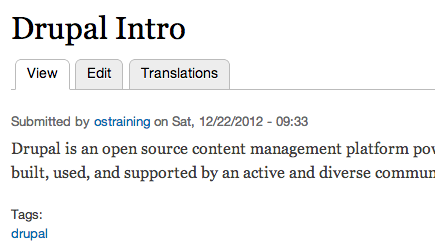Over the last few months, we've been covering the Drupal community's progress towards releasing Drupal 8.
Our last update was a month ago. I explained that the core file structure had changed, plus there were over 15 new modules including Views.
Since that update, the first major deadline has arrived. Feature freeze was in the beginning of December, although that deadline slipped a little, and we can still expect new features until February.
However, lots of great new features have arrived in the last month, and so let's take another look at the state of Drupal 8.
Toolbar
Drupal 8 has a new toolbar that's considerably shorter and more concise than anything we've seen in previous versions. The toolbar also includes icons for the first time.

The main navigation elements that you'd expect to see in Drupal are now under the "Menu" tab. The terminology is almost the same as Drupal 7, except that "Modules" has been replaced by "Extend".

This toolbar is mobile-ready:

On mobile screens, the sub-links move to the sidebar. This sidebar menu is available as an option for desktop users too.

Inline Editing
One of the most exciting new features in Drupal 8 is inline editing. Whenever you're on any content page, click "Edit" in the toolbar.

You'll see that your content elements are highlighted:

Click any element and you'll see it pop out of the page:

You'll be able to edit the save the content directly from your current page:

Currently this editing is available only for content fields. I presume it may later be extended to allow the editing of content titles and other elements.
Contact Form
Presumably to help make Drupal more friendly for entry-level site builder, the Contact form module is now enabled by default:

You can add fields to the form so it will be quick and easy to expand the contact forms:

Cleaner Interfaces
One thing I haven't heard mention, but that struck me in Drupal 8, was that a lot of interfaces have been cleaned up.
In Drupal 7, screens like this contain at least 4 links for each content type.

The same was true with the menu screens. Some of the links are hidden under the dropdowns on the right, but many have been removed entirelyl

The Modules / Extend screen has also been greatly simplified.

All in all, it looks like there's been a real effort to reduce the information overload on many of these screens.
Language Translation
Three new language translation modules have been added to Drupal 8:

Inside Configuration > Languages, you can quickly click and Add languages.
At the moment, because Drupal 8 is still in development, the admin interface still needs to be translated manually, hence the 0/300 score in the image below.

The Drupal core will now automatically attempt to detect the language preferences of both visitors and administrators:

Every time you want to translate something, you need to give explicit permission. For example, if you want to translate a content type, you first need to edit that content type and enable translations.

Then you need to enable translations for each field within that content type:

Once that's done, you'll see a Translations tab on content items:

Translations also appear in the contextual links:

Once you click either of these links you'll get a translation screen like the one below:

The translation screen for each language looks exactly like the screen for your default language.





















































